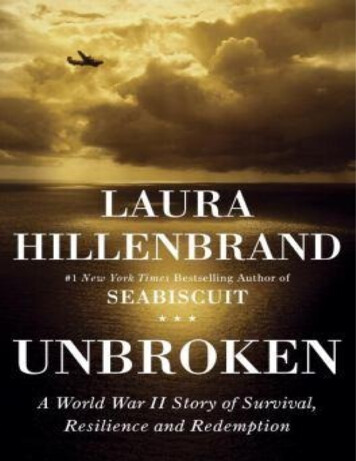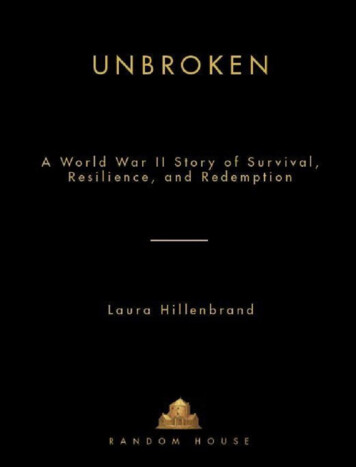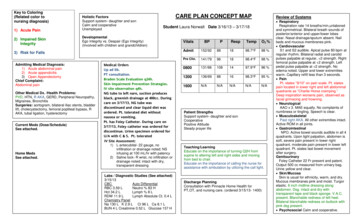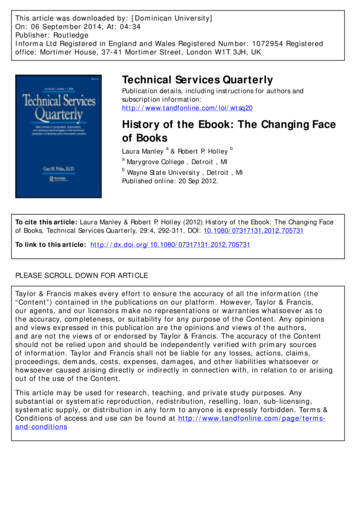
Transcription
Also by Laura HillenbrandSEABISCUIT
Copyright 2010 by Laura HillenbrandAll rights reserved.Published in the United States by Random House, an imprint of The Random HousePublishing Group, a division of Random House, Inc., New York.RANDOM HOUSE and colophon are registered trademarks of Random House, Inc.LIBRARY OF CONGRESS CATALOGING-IN-PUBLICATION DATAHillenbrand, Laura.Unbroken : a World War II story of survival, resilience, and redemption / LauraHillenbrand.p. cm.eISBN: 978-0-679-60375-71. Zamperini, Louis, 1917– 2. World War, 1939–1945—Prisoners and prisons,Japanese. 3. Prisoners of war—United States—Biography. 4. Prisoners of war—Japan—Biography. 5. World War, 1939–1945—Aerial operations, American. 6.World War, 1939–1945—Campaigns—Pacific Area. 7. United States. Army AirForces. Heavy Bombardment Group, 307th. 8. Long-distance runners—United States—Biography. I. Title.D805.J3Z364 2010940.54′7252092—dc22[B] 2010017517www.atrandom.comv3.1
For the wounded and the lost
What stays with you latest and deepest? of curious panics,Of hard-fought engagements or sieges tremendous what deepest remains?—Walt Whitman, “The Wound-Dresser”
CONTENTSCoverOther Books by This AuthorTitle ter1. The One-Boy InsurgencyChapter 2. Run Like MadChapter 3. The Torrance TornadoChapter 4. Plundering GermanyChapter 5. Into WarPARTIIChapter6. The Flying CoffinChapter 7. “This Is It, Boys”Chapter 8. “Only the Laundry Knew How Scared I Was”Chapter 9. Five Hundred and Ninety-four HolesChapter 10. The Stinking SixChapter 11. “Nobody’s Going to Live Through This”PARTIIIChapter12. DownedChapter 13. Missing at SeaChapter 14. ThirstChapter 15. Sharks and BulletsChapter 16. Singing in the CloudsChapter 17. TyphoonPARTIVChapter18. A Dead Body BreathingChapter 19. Two Hundred Silent MenChapter 20. Farting for HirohitoChapter 21. BeliefChapter 22. Plots AfootChapter 23. MonsterChapter 24. HuntedChapter 25. B-29
Chapter 26. MadnessChapter 27. Falling DownChapter 28. EnslavedChapter 29. Two Hundred and Twenty PunchesChapter 30. The Boiling CityChapter 31. The Naked StampedeChapter 32. Cascades of Pink PeachesChapter 33. Mother’s DayPARTVChapter34. The Shimmering GirlChapter 35. Coming UndoneChapter 36. The Body on the MountainChapter 37. Twisted RopesChapter 38. A Beckoning WhistleChapter 39. DaybreakEpilogueAcknowledgmentsNotesAbout the Author
PREFACEALL HE COULD. It was June 23, 1943.Somewhere on the endless expanse of the Pacific Ocean, Army Air Forcesbombardier and Olympic runner Louie Zamperini lay across a small raft, driftingwestward. Slumped alongside him was a sergeant, one of his plane’s gunners. On aseparate raft, tethered to the first, lay another crewman, a gash zigzagging across hisforehead. Their bodies, burned by the sun and stained yellow from the raft dye, hadwinnowed down to skeletons. Sharks glided in lazy loops around them, draggingtheir backs along the rafts, waiting.The men had been adrift for twenty-seven days. Borne by an equatorial current,they had floated at least one thousand miles, deep into Japanese-controlled waters.The rafts were beginning to deteriorate into jelly, and gave off a sour, burning odor.The men’s bodies were pocked with salt sores, and their lips were so swollen thatthey pressed into their nostrils and chins. They spent their days with their eyes fixedon the sky, singing “White Christmas,” muttering about food. No one was evenlooking for them anymore. They were alone on sixty-four million square miles ofocean.A month earlier, twenty-six-year-old Zamperini had been one of the greatestrunners in the world, expected by many to be the first to break the four-minute mile,one of the most celebrated barriers in sport. Now his Olympian’s body had wasted toless than one hundred pounds and his famous legs could no longer lift him. Almosteveryone outside of his family had given him up for dead.On that morning of the twenty-seventh day, the men heard a distant, deepstrumming. Every airman knew that sound: pistons. Their eyes caught a glint in thesky—a plane, high overhead. Zamperini fired two flares and shook powdered dyeinto the water, enveloping the rafts in a circle of vivid orange. The plane kept going,slowly disappearing. The men sagged. Then the sound returned, and the plane cameback into view. The crew had seen them.With arms shrunken to little more than bone and yellowed skin, the castawayswaved and shouted, their voices thin from thirst. The plane dropped low and sweptalongside the rafts. Zamperini saw the profiles of the crewmen, dark against brightblueness.There was a terrific roaring sound. The water, and the rafts themselves, seemed toboil. It was machine gun fire. This was not an American rescue plane. It was aJapanese bomber.The men pitched themselves into the water and hung together under the rafts,SEE, IN EVERY DIRECTION, WAS WATER
cringing as bullets punched through the rubber and sliced effervescent lines in thewater around their faces. The firing blazed on, then sputtered out as the bomberovershot them. The men dragged themselves back onto the one raft that was stillmostly inflated. The bomber banked sideways, circling toward them again. As itleveled off, Zamperini could see the muzzles of the machine guns, aimed directly atthem.Zamperini looked toward his crewmates. They were too weak to go back in thewater. As they lay down on the floor of the raft, hands over their heads, Zamperinisplashed overboard alone.Somewhere beneath him, the sharks were done waiting. They bent their bodies inthe water and swam toward the man under the raft.
Courtesy of Louis Zamperini. Photo of original image by John Brodkin.
OneThe One-Boy InsurgencyIN THE PREDAWN DARKNESS OF AUGUST 26, 1929, IN THE back bedroom of a small housein Torrance, California, a twelve-year-old boy sat up in bed, listening. There was asound coming from outside, growing ever louder. It was a huge, heavy rush,suggesting immensity, a great parting of air. It was coming from directly above thehouse. The boy swung his legs off his bed, raced down the stairs, slapped open theback door, and loped onto the grass. The yard was otherworldly, smothered inunnatural darkness, shivering with sound. The boy stood on the lawn beside his olderbrother, head thrown back, spellbound.The sky had disappeared. An object that he could see only in silhouette, reachingacross a massive arc of space, was suspended low in the air over the house. It waslonger than two and a half football fields and as tall as a city. It was putting out thestars.What he saw was the German dirigible Graf Zeppelin. At nearly 800 feet long and110 feet high, it was the largest flying machine ever crafted. More luxurious than thefinest airplane, gliding effortlessly over huge distances, built on a scale that leftspectators gasping, it was, in the summer of ’29, the wonder of the world.The airship was three days from completing a sensational feat of aeronautics,circumnavigation of the globe. The journey had begun on August 7, when theZeppelin had slipped its tethers in Lakehurst, New Jersey, lifted up with a long, slowsigh, and headed for Manhattan. On Fifth Avenue that summer, demolition was soonto begin on the Waldorf-Astoria Hotel, clearing the way for a skyscraper ofunprecedented proportions, the Empire State Building. At Yankee Stadium, in theBronx, players were debuting numbered uniforms: Lou Gehrig wore No. 4; BabeRuth, about to hit his five hundredth home run, wore No. 3. On Wall Street, stockprices were racing toward an all-time high.After a slow glide around the Statue of Liberty, the Zeppelin banked north, thenturned out over the Atlantic. In time, land came below again: France, Switzerland,Germany. The ship passed over Nuremberg, where fringe politician Adolf Hitler,whose Nazi Party had been trounced in the 1928 elections, had just delivered aspeech touting selective infanticide. Then it flew east of Frankfurt, where a Jewishwoman named Edith Frank was caring for her newborn, a girl named Anne. Sailingnortheast, the Zeppelin crossed over Russia. Siberian villagers, so isolated thatthey’d never even seen a train, fell to their knees at the sight of it.
On August 19, as some four million Japanese waved handkerchiefs and shouted“Banzai!” the Zeppelin circled Tokyo and sank onto a landing field. Four days later,as the German and Japanese anthems played, the ship rose into the grasp of atyphoon that whisked it over the Pacific at breathtaking speed, toward America.Passengers gazing from the windows saw only the ship’s shadow, following it alongthe clouds “like a huge shark swimming alongside.” When the clouds parted, thepassengers glimpsed giant creatures, turning in the sea, that looked like monsters.On August 25, the Zeppelin reached San Francisco. After being cheered down theCalifornia coast, it slid through sunset, into darkness and silence, and acrossmidnight. As slow as the drifting wind, it passed over Torrance, where its onlyaudience was a scattering of drowsy souls, among them the boy in his pajamasbehind the house on Gramercy Avenue.Standing under the airship, his feet bare in the grass, he was transfixed. It was, hewould say, “fearfully beautiful.” He could feel the rumble of the craft’s enginestilling the air but couldn’t make out the silver skin, the sweeping ribs, the finned tail.He could see only the blackness of the space it inhabited. It was not a great presencebut a great absence, a geometric ocean of darkness that seemed to swallow heavenitself.——The boy’s name was Louis Silvie Zamperini. The son of Italian immigrants, he hadcome into the world in Olean, New York, on January 26, 1917, eleven and a halfpounds of baby under black hair as coarse as barbed wire. His father, Anthony, hadbeen living on his own since age fourteen, first as a coal miner and boxer, then as aconstruction worker. His mother, Louise, was a petite, playful beauty, sixteen atmarriage and eighteen when Louie was born. In their apartment, where only Italianwas spoken, Louise and Anthony called their boy Toots.From the moment he could walk, Louie couldn’t bear to be corralled. His siblingswould recall him careening about, hurdling flora, fauna, and furniture. The instantLouise thumped him into a chair and told him to be still, he vanished. If she didn’thave her squirming boy clutched in her hands, she usually had no idea where he was.In 1919, when two-year-old Louie was down with pneumonia, he climbed out hisbedroom window, descended one story, and went on a naked tear down the streetwith a policeman chasing him and a crowd watching in amazement. Soon after, on apediatrician’s advice, Louise and Anthony decided to move their children to thewarmer climes of California. Sometime after their train pulled out of Grand CentralStation, Louie bolted, ran the length of the train, and leapt from the caboose.Standing with his frantic mother as the train rolled backward in search of the lostboy, Louie’s older brother, Pete, spotted Louie strolling up the track in perfectserenity. Swept up in his mother’s arms, Louie smiled. “I knew you’d come back,”
he said in Italian.In California, Anthony landed a job as a railway electrician and bought a half-acrefield on the edge of Torrance, population 1,800. He and Louise hammered up a oneroom shack with no running water, an outhouse behind, and a roof that leaked sobadly that they had to keep buckets on the beds. With only hook latches for locks,Louise took to sitting by the front door on an apple box with a rolling pin in herhand, ready to brain any prowlers who might threaten her children.There, and at the Gramercy Avenue house where they settled a year later, Louisekept prowlers out, but couldn’t keep Louie in hand. Contesting a footrace across abusy highway, he just missed getting broadsided by a jalopy. At five, he startedsmoking, picking up discarded cigarette butts while walking to kindergarten. Hebegan drinking one night when he was eight; he hid under the dinner table, snatchedglasses of wine, drank them all dry, staggered outside, and fell into a rosebush.On one day, Louise discovered that Louie had impaled his leg on a bamboo beam;on another, she had to ask a neighbor to sew Louie’s severed toe back on. WhenLouie came home drenched in oil after scaling an oil rig, diving into a sump well,and nearly drowning, it took a gallon of turpentine and a lot of scrubbing beforeAnthony recognized his son again.Thrilled by the crashing of boundaries, Louie was untamable. As he grew into hisuncommonly clever mind, mere feats of daring were no longer satisfying. InTorrance, a one-boy insurgency was born.——If it was edible, Louie stole it. He skulked down alleys, a roll of lock-picking wire inhis pocket. Housewives who stepped from their kitchens would return to find thattheir suppers had disappeared. Residents looking out their back windows might catcha glimpse of a long-legged boy dashing down the alley, a whole cake balanced on hishands. When a local family left Louie off their dinner-party guest list, he broke intotheir house, bribed their Great Dane with a bone, and cleaned out their icebox. Atanother party, he absconded with an entire keg of beer. When he discovered that thecooling tables at Meinzer’s Bakery stood within an arm’s length of the back door, hebegan picking the lock, snatching pies, eating until he was full, and reserving the restas ammunition for ambushes. When rival thieves took up the racket, he suspendedthe stealing until the culprits were caught and the bakery owners dropped theirguard. Then he ordered his friends to rob Meinzer’s again.It is a testament to the content of Louie’s childhood that his stories about itusually ended with “ and then I ran like mad.” He was often chased by people hehad robbed, and at least two people threatened to shoot him. To minimize theevidence found on him when the police habitually came his way, he set up lootstashing sites around town,
31.08.2017 · Unbroken : a World War II story of survival, resilience, and redemption / Laura Hillenbrand. p. cm. eISBN: 978-0-679-60375-7 1. Zamperini, Louis, 1917– 2. World War, 1939–1945—Prisoners and prisons, Japanese. 3. Prisoners of war—United States—Biography. 4. Prisoners of war— Japan—Biography. 5. World War, 1939–1945—Aerial operations, American. 6.











